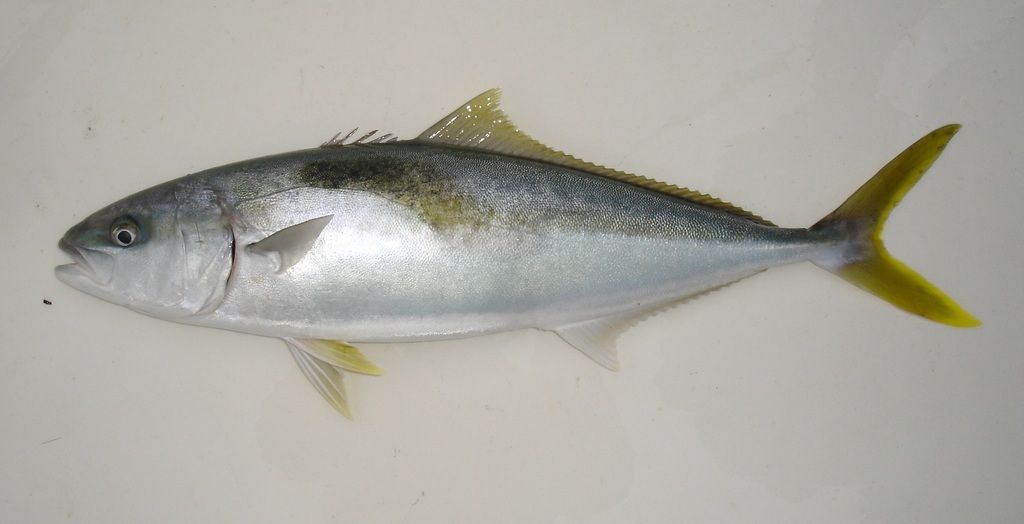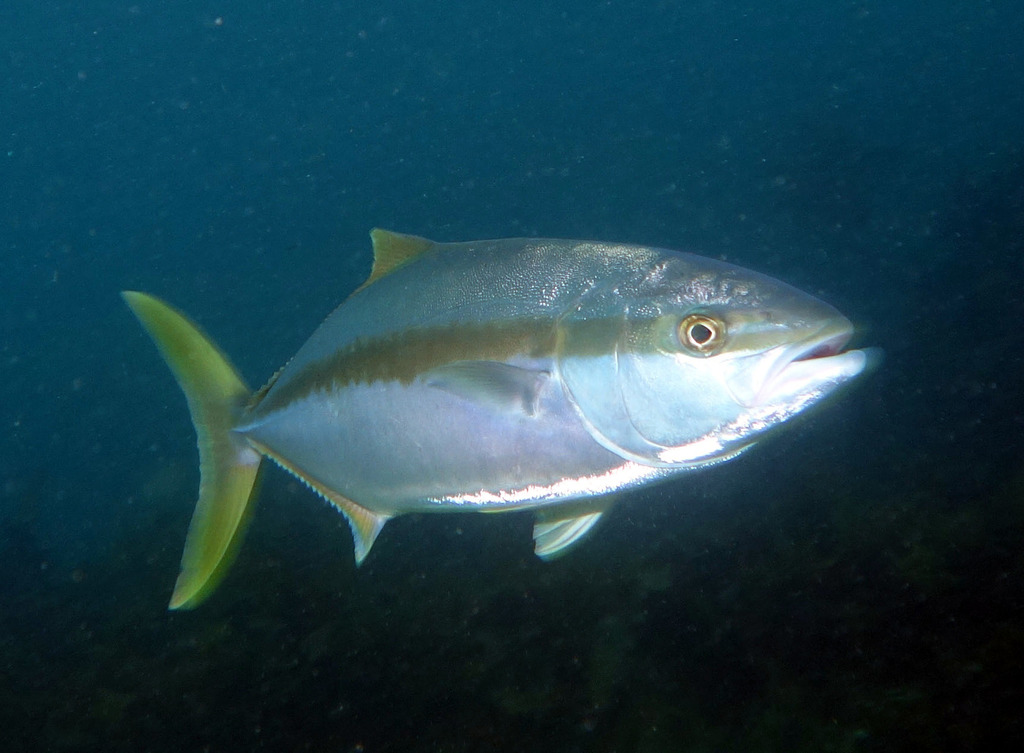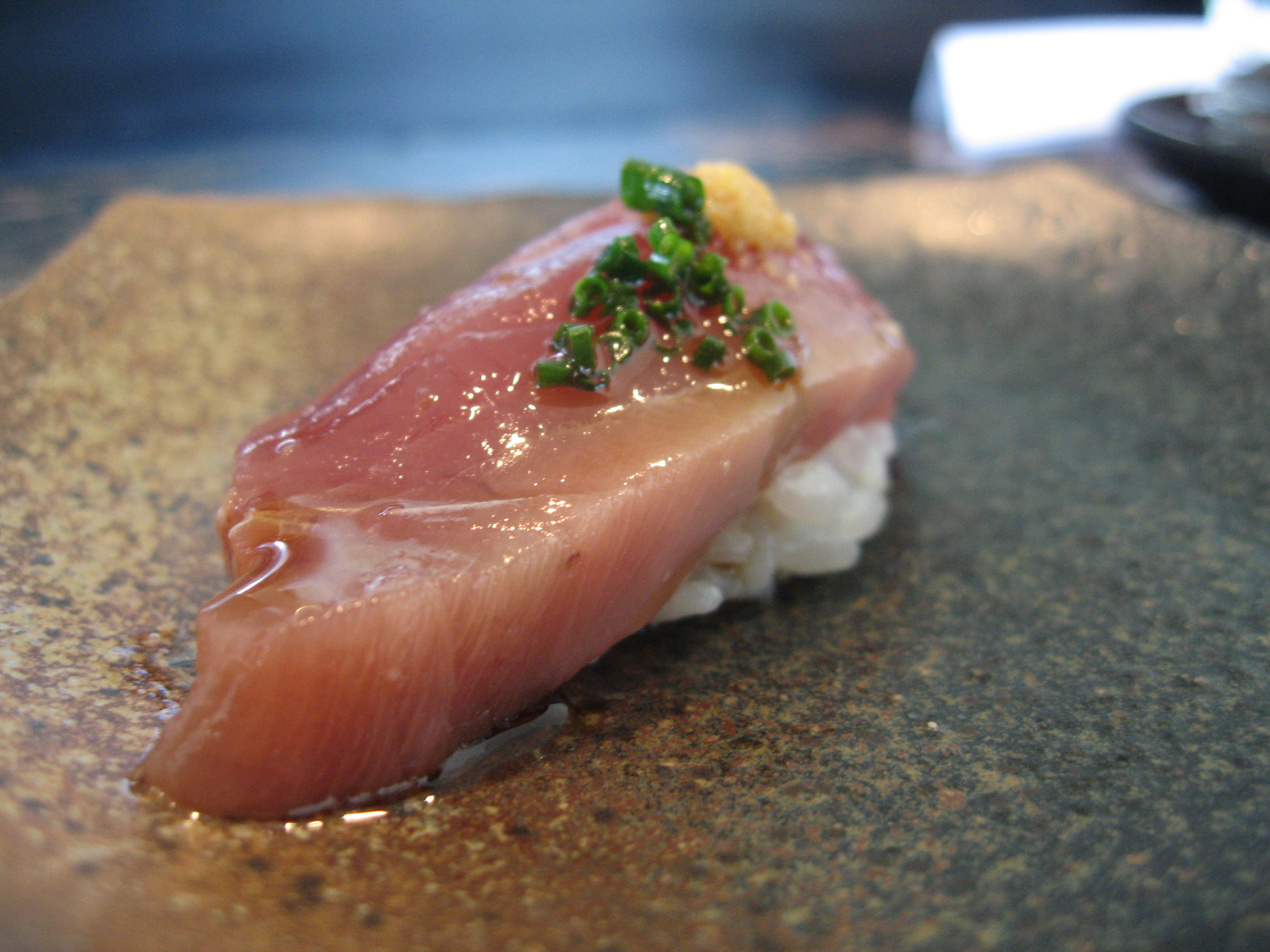Seriola lalandi
North Coast (Oregon Border to Point Arena)
North Central Coast (South of Point Arena to Half Moon Bay)
Central Coast (South of Half Moon Bay to Point Conception)
Santa Barbara (Point Conception to Point Dume)
South Coast (Point Dume to Mexico border)
Flakey fish
Oily fish
Wild caught

The Science

Taxonomic description
- Has a blue body, yellow tail, and silver sides with a bronzy stripe along the lateral line. [2]
- Grows to 2.5 m in length and weighs up to 36.3 kg, with the largest weighing in at 41.3 kg (91.1 lbs). [2]
Distribution
- Found along the eastern Pacific from southern Washington to Mazatlán, Mexico (for California Yellowtail). [1]
Life history
- Has an average lifespan of 5-6 years with a max of 12 years. [2]
- Females can spawn at 2-3 years old and release up to 150 eggs during spawning, but about 100 eggs are fertilized at a time. Yellowtail eggs are externally fertilized, with the females releasing eggs into the water column, and the males spraying sperm over the eggs. [2]
- Spawning occurs during the summer, from June to October. [10] Younger females spawn once during the spawning season, while older ones can spawn multiple times. [2]
Habitat
- Lives near rocky reefs, kelp beds, and offshore islands. [2]
- The eggs and larvae are eaten by mollusks, echinoderms, crabs, and fish. [2]
- Common predators of adults are great white sharks, California sea lions, and humans; the fish’s blue and silvery color is an adaptation to help camouflage from predators. [2]
- Preys on round herring, sardines, squids, anchovies, and California flying fish. [2]
The Fishery
Seasonal availability
- Fishing is open year-round, but between May and August limits to pounds of yellowtail per boat apply. [4]
Regulatory and managing authority
- As established by the Marine Life Management Act, the California Fish and Game Commission regulates the fishery, and the California Department of Fish and Wildlife manages this fishery. [12]
- As yellowtail is caught as bycatch by fisheries targeting other species, this species is not included in any specific fishery management plan, but still falls under the jurisdiction of NOAA fisheries under the Marine Mammal Protection Act and CDFW and CFGC as per the Marine Life Management Act. [6,12]
Gear type
- Sometimes caught as incidental catch in the drift gillnet fishery, and is also targeted with hook and line. If targeting yellowtail with drift gillnets, the mesh size must be ≥3.5 inches. [6]
Status of the fishery
- Is a largely sought after sportfish, but no decline in population sizes has been detected. [7]
- Commercial catch declined when purse seining (1973), and later, gillnets (1994) were banned in California waters (CDFG 2001). [1]
- There is currently no stock assessment or fishery management plan in place for California yellowtail. [1]
- Currently no conservation acts apply. [1]
Potential ecosystem impacts
- Yellowtail is a secondary and tertiary consumer in its ecosystems, so its presence helps create the population structure for its prey. Removal of yellowtail may impact populations of its prey and predators. [2]
The Seafood

 Edible portions
Edible portions
- The meat (muscle), head and roe are edible, remaining parts may be used in broth or soups. [3]
Description of meat
- Light red to pink in color, and buttery due to its high oil content. [3]
Culinary uses
- Yellowfin is commonly used raw in sushi as sashimi or smoked. [3]
- It is sold fresh and frozen, and whole, in fillets or steaks. [3]
- Recommended cooking styles include broil, grill, and saute.
- For yellowfin tuna recipes, visit yummly. [13]
Nutritional information
- 66% of the calories are from protein, while the rest 34% are from fat. [10]
Toxicity report
- Yellowtail have high levels of histidine, which is converted to histamine by bacteria when the fish spoils and can cause histamine toxicity. To avoid this, make sure to refrigerate the fish properly and do not eat if spoiled. [5]
Seasonal availability
- It is available year round. [1]
References
[1] James, K. 2014. California yellowtail, White seabass. Web. https://www.seafoodwatch.org/-/m/sfw/pdf/reports/s/mba_seafoodwatch_caye.... Accessed 30 May 2017
[2] Sandoval, J. 2017. Seriola lalandi. Web. http://animaldiversity.org/accounts/Seriola_lalandi. Accessed 30 May 2017
[3]Seafood Source. 2014. Yellowtail. Web. https://www.seafoodsource.com/seafood-handbook/finfish/yellowtail#introd.... Accessed 29 May 2017
[4] California Department of Fish and Wildlife. n.d. California Commercial Fishing Digest. Web. https://wildlife.ca.gov/Fishing/Commercial#310591031-selected-publications. Accessed 17 Sept 2020.
[5] American Academy of Allergy Asthma and Immunology, 2017. Histamine Toxicity. Web. http://www.aaaai.org/conditions-and-treatments/related-conditions/histam.... Accessed 30 May 2017
[6] NOAA fisheries. n.d. CA Yellowtail, Barracuda, White Seabass Drift Gillnet Fishery--MMPA List of Fisheries. Web. https://www.fisheries.noaa.gov/national/marine-mammal-protection/ca-yellowtail-barracuda-white-seabass-drift-gillnet-fishery-mmpa. Accessed 17 Sept 2020.
[7] IUCN Red List, 2017. Seriola lalandi. Web. http://www.iucnredlist.org/details/195097/0. Accessed 30 May 2017.
[8] CA Department of Fish and Wildlife, 2013. California Marine Sportfish Identification. Web. https://www.wildlife.ca.gov/Fishing/Ocean/Fish-ID/Sportfish/Other-Fishes.... Accessed 30 May 2017.
[9] Crooke, S. 2001. Status of the Fisheries Report, Yellowtail. California Department of Fish and Wildlife. Web. https://wildlife.ca.gov/Conservation/Marine/Status/2001#28129684-nearshore-ecosystem-fish-resources. Accessed 17 Sept 2020.
[10] Yellowtail. n.d. Nutritionvalue.org. Web. https://www.nutritionvalue.org/Fish%2C_raw%2C_mixed_species%2C_yellowtail_nutritional_value.html. Accessed 21 September 2017.
[11] Hutson, K. 2007. National Library of Australia. Parasite interactions between wild and farmed yellowtail kingfish (Seriola lalandi) in southern Australia. Web. https://trove.nla.gov.au/work/36394415. Accessed 17 Sept 2020.
[12] Marine Life Management Act. n.d. California Department of Fish and Wildlife. Web. https://wildlife.ca.gov/Conservation/Marine/MLMA. Accessed 24 August 2020.
[13] yummly. n.d. Yellowfin Tuna Recipes. Web. https://www.yummly.com/recipes/yellowfin-tuna. Accessed 4 February 2021.
[14] Duffy, C. 2015. Digital image. Web. https://www.inaturalist.org/photos/6449389. Accessed 26 February 2021.
[15] Turnbull, J. 2013. Digital image. Web. https://www.inaturalist.org/photos/5853956. Accessed 26 February 2021.
[16] Dollete, R. 2007. Yellowtail. Digital image. Web. https://flickr.com/photos/saucesupreme/5462788927. Accessed 26 February 2021.
